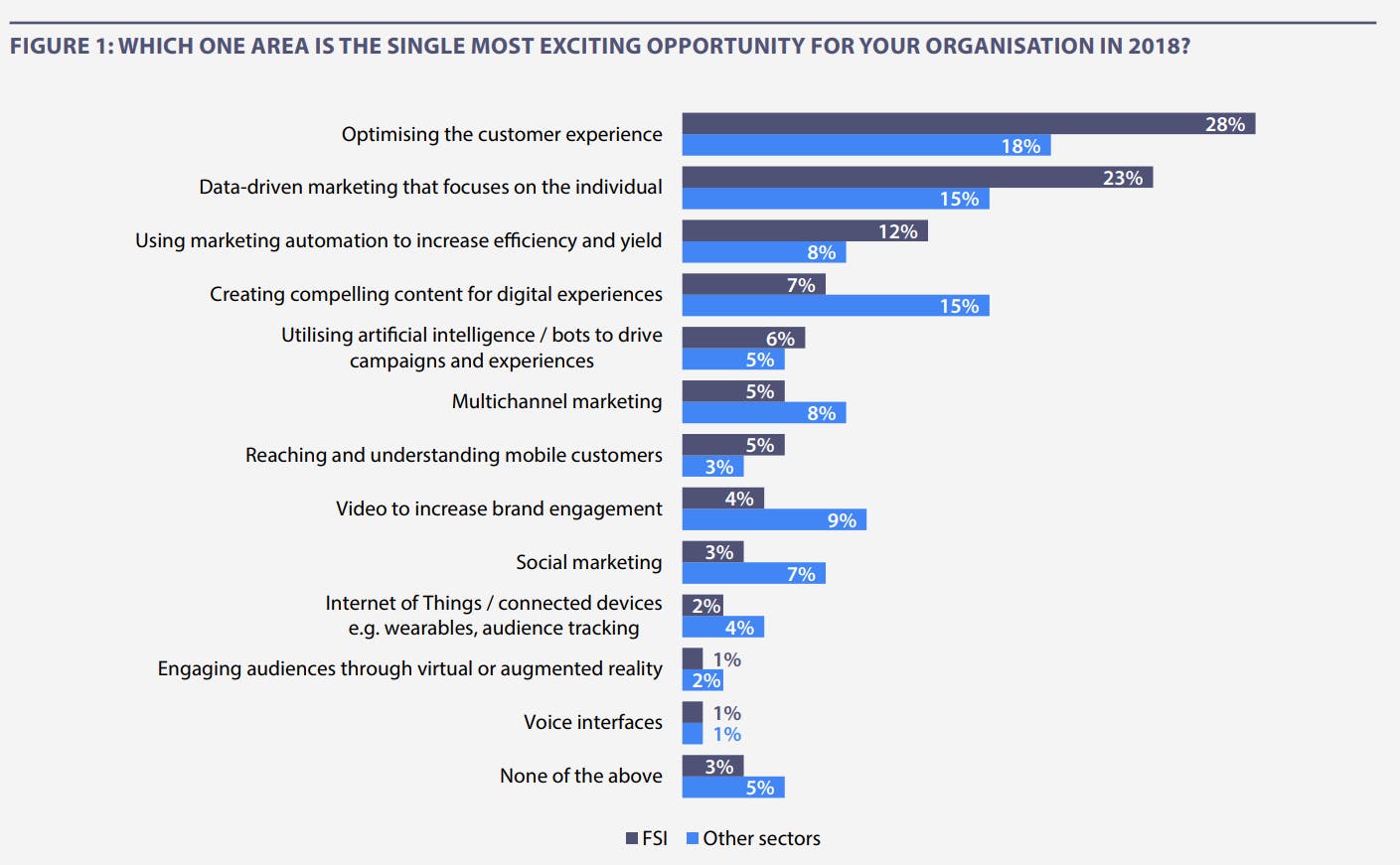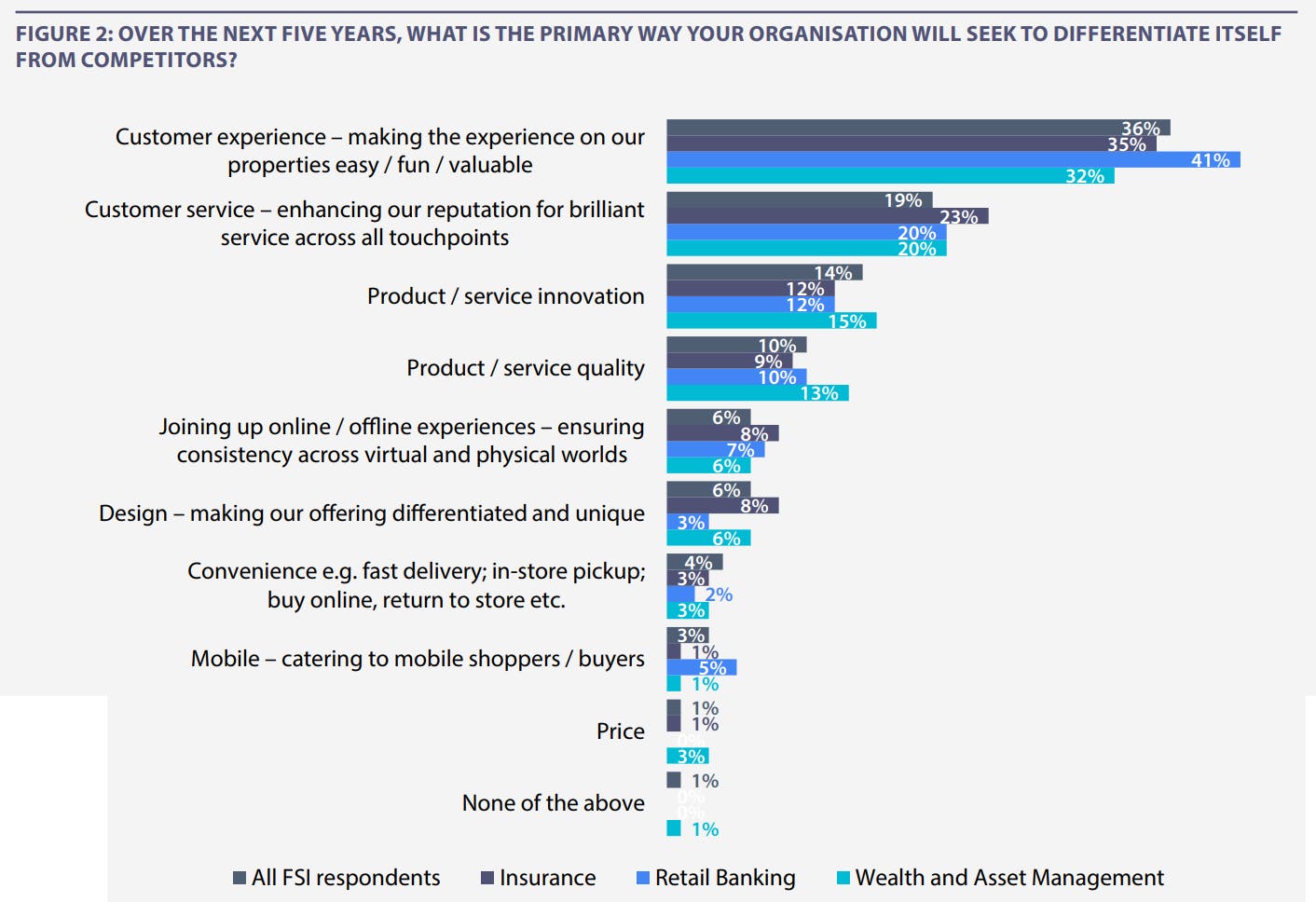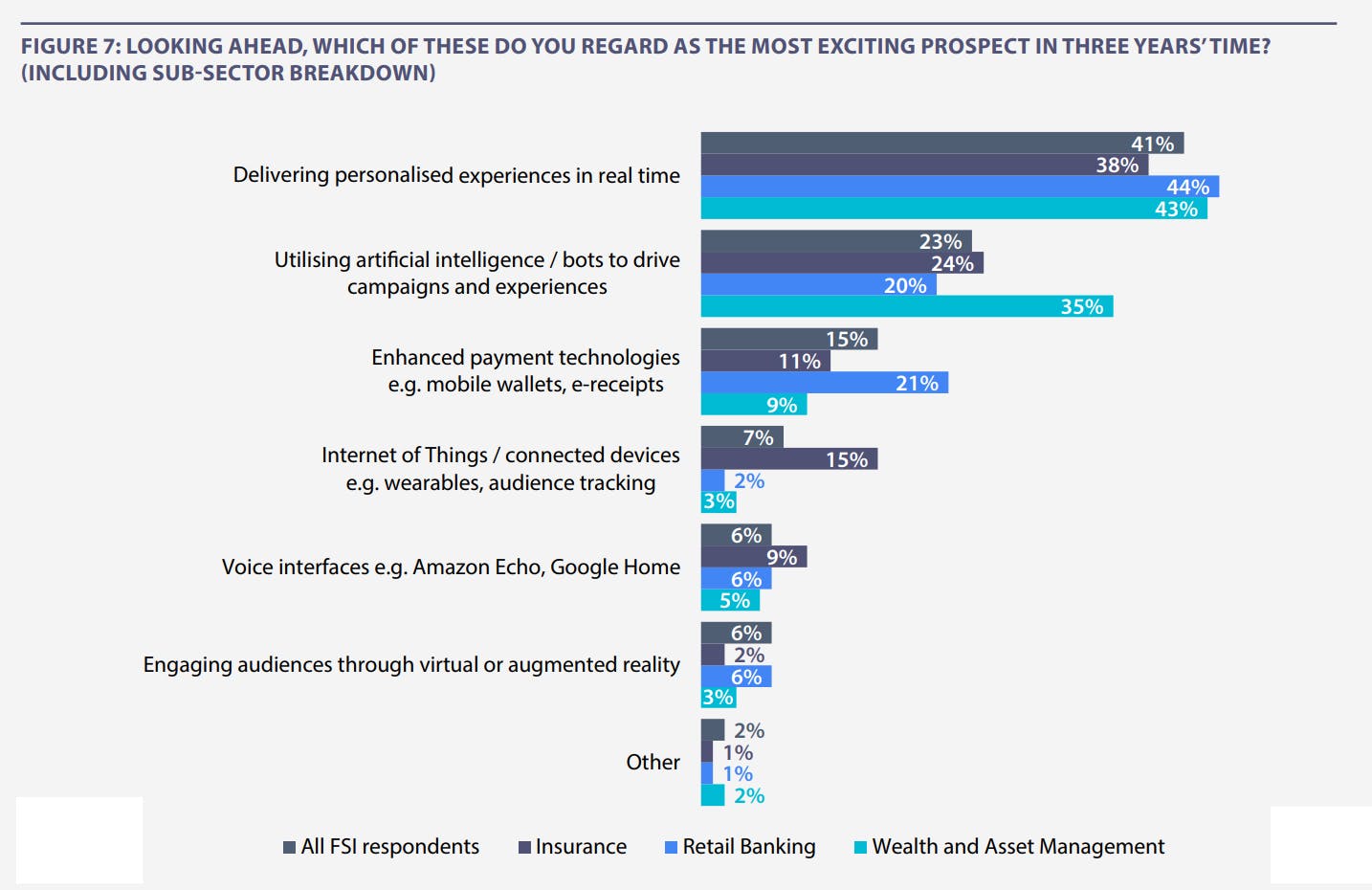The advent of smartphones and financial services apps in particular has raised consumers’ expectations for what a financial service should consist of. They expect it to be seamless, accessible, intuitive, and personal.
The 2018 Digital Trends in Financial Services report from Econsultancy and Adobe sheds some light onto how financial institutions are responding to these challenges. In particular, it highlights the extent to which FSI companies have turned their attention to optimising the customer experience, and why they are making it a top priority now and over the coming few years.
Committing to customer experience
The Digital Trends in Financial Services sector report surveyed more than 650 respondents working in a variety of roles across the financial services sector, in industries including retail banking, wealth and asset management, property and casualty insurance, and life insurance.
Of these, 28% cited “optimising the customer experience” as the single most exciting opportunity for their organisation in 2018. A further 23% singled out “data-driven marketing that focuses on the individual” as the most exciting opportunity – a discipline itself that can be integral to improving the customer experience.
In both of these instances, financial services respondents were ahead of respondents in other sectors surveyed by Econsultancy and Adobe (of which there were a wide variety, including retail and ecommerce, travel and hospitality, government, consumer goods and more). Only 18% of respondents in other sectors were excited about optimising the customer experience in 2018, while 15% were most excited by the opportunity of data-driven marketing.
But the financial services sector lags behind other sectors in one area which is crucial for customer experience: creating compelling content for digital experiences. Just 7% of financial services respondents named this as the most exciting challenge for 2018, compared to 15% of respondents from other sectors.

“Great content, across formats ranging from email and social, to website copy and display advertising, is essential for powering the digital customer experience,” notes the report author. Will the financial services sector’s lack of enthusiasm for great content be the undoing of its plans to revolutionise the customer experience?
Not necessarily. FSI companies may just be focusing on the big picture first, before they turn their attention to content.
“A new trend we are starting to see from leaders in the FSI space … is a focus on creating content to power digital experiences once they have understood the bigger CX picture,” the report states.
“Unlike their peers in other sectors who set up advanced CX programmes many years ago, FSI companies have yet to learn the demands a good CX journey has on content. Only those who grasp the full requirements understand the need to produce content at scale and at speed.”
It therefore seems likely that, if financial services institutions aren’t prioritising compelling content in 2018, they will start to do so more urgently in the next couple of years. This is because many of them anticipate making customer experience a point of differentiation from competitors over the coming five years.
More than a third (36%) of respondents from FSI companies specified “Customer experience – making the experience on our properties easy/fun/valuable” as the primary way their organisation will seek to differentiate itself from competitors over the next five years.
This percentage was highest among retail banking respondents, more than two fifths (41%) of whom stated that their organisation would seek to differentiate itself via the customer experience.

A further fifth (19%) of FSI respondents are aiming to set themselves apart by focusing on the customer in a different way: via excellent customer service.
This percentage was highest among respondents from insurance companies, 23% of whom chose “Customer service – enhancing our reputation for brilliant service across all touchpoints” as the primary way their organisation would differentiate itself over the coming five years.
It could be argued that customer service is just another component of the customer experience, as it’s hard to have an excellent customer experience if customer service is poor. All in all, it means that more than half (55%) of FSI companies will seek to differentiate themselves by putting the customer first in some form over the next five years.
A customer experience wake-up call
Earlier in this piece, I talked about the fact that the financial services sector is more competitive than ever, which is prompting traditional FSI companies to respond by optimising the customer experience.
But why are financial institutions choosing to focus on the customer and not become more competitive by, say, enhancing their technological offering? Craig Corte, Chief Digital and Design Officer at Barclays Africa Group, believes that it’s because they’re waking up to the need to truly solve customer problems:
Banks have traditionally been very good at building product and then putting it in front of customers. They have never taken enough time to really think about whether they are solving customer problems.
I think as we move into much more competitive arenas, where competitors are less likely to be other banks, this realisation that we are fundamentally now working for customers, ironically, is starting to land.
So, with customer experience well-established as the priority for FSI companies now and in the near future, what are financial institutions doing to improve the customer experience?
Many of them are turning their attention to personalisation, which can be a key way of making the customer feel valued and prioritised, as well as of creating a more memorable customer experience.
When asked which three digital-related areas are the top priorities for their organisation in 2018, 37% of respondents from the financial services sector chose “Targeting and personalisation”, compared with 23% of respondents from other sectors.
More than two-fifths (41%) of respondents from FSI companies also cited “delivering personalised experiences in real-time” as their most exciting prospect for the medium-term (the next three years). Once again, retail banking respondents were the most enthusiastic here, with 44% naming real-time personalised experiences as their most exciting medium-term prospect.

And financial services institutions are prepared to put their money where their mouths are: close to two-thirds (62%) of respondents from FSI companies say that they are planning to increase their budgets for personalisation in 2018, compared with 53% of respondents from other sectors.
The challenge facing legacy financial institutions with regards to personalisation is best summed up by this paragraph in the Digital Trends report:
“According to the World Fintech Report 2018, published by Capgemini and LinkedIn, digital-first organisations are much better positioned to provide the kind of highly personalised and customised solutions that consumers are increasingly expecting. Despite having access to enormous volumes of customer insights, the pressure is on legacy organisations to apply these insights for the benefit of the consumer in the form of personalised and contextualised information.”
People, process and technology
It’s clear from these findings that the intent to improve the customer experience in financial services is absolutely there, and many companies have honed in on and allocated budget towards areas that are relevant to achieving this, such as personalisation.
Nevertheless, for many others, setting out to adopt a customer-centric strategy can be a daunting prospect, and it’s difficult to know where to begin. Jamie Brighton, Head of Product Marketing for Adobe Experience Cloud in EMEA, gives this advice:
“Too many brands become paralysed by not knowing where to start or how to approach the adoption of a customer-centric strategy. Essentially, digital transformation is about people, process and technology, and you need the right mix of skills and an environment for people to flourish in, as well as the right technology to enable them.”
For more insights into the challenges and opportunities facing the financial services sector in 2018, download the 2018 Digital Trends in Financial Services report now.
Check out Econsultancy’s Customer Experience Training Masterclass.

Comments